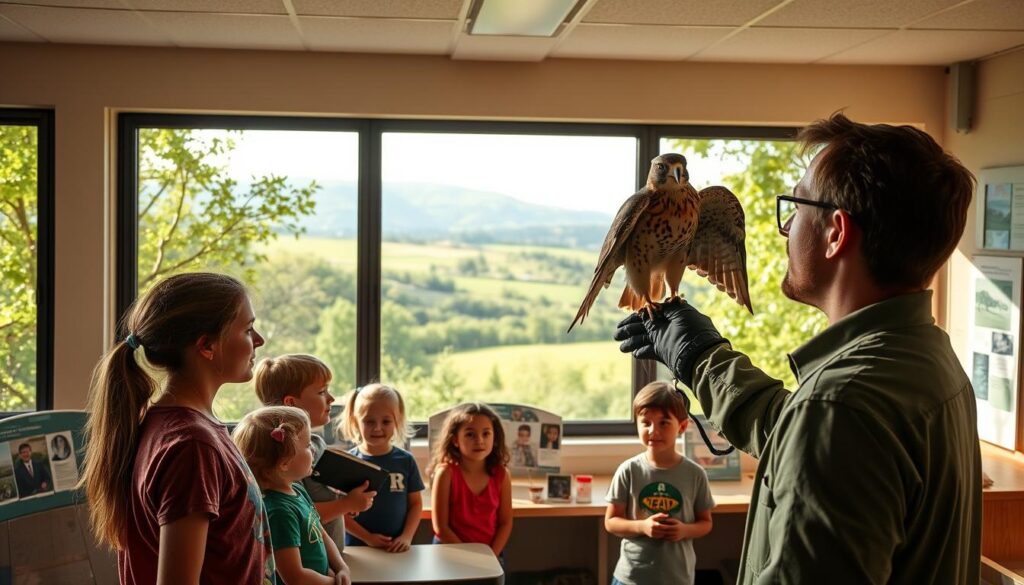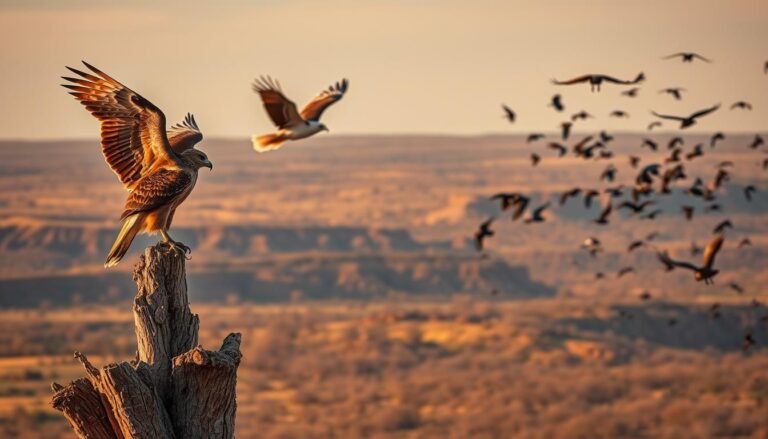As I wander through Texas’s varied landscapes, I am always amazed by the different raptors here. These birds of prey are impressive predators in the sky. They have special traits that let them live in many places. From the high-flying Bald Eagle to the hidden Great Horned Owl, Texas’s raptors are a vital part of our nature.
This article will take a closer look at Texas raptors, their kinds, homes, and ways of living. We will also talk about how people are working to keep these amazing birds safe, especially the ones in danger. Getting to know Texas raptors makes us value them more and helps us protect them. Let’s learn about the remarkable birds of prey that call Texas home.
Key Takeaways
- Texas is full of different raptors, each with its own way of adapting.
- The Bald Eagle’s wings can stretch from 6 to 7.5 feet, making it one of the biggest raptors.
- It’s very important to protect raptors at risk, like the aplomado falcon.
- Raptors are most lively at the start and end of the day, giving us great chances to see them.
- Knowing how to spot them will help bird watchers recognize these special birds.
Introduction to Texas Raptors
Raptors are important for our environment. These birds of prey are known for their hunting skills and unique features. They have sharp claws, curved beaks, and great eyesight. These traits make them top hunters. Raptors eat different animals, helping control those populations.
What Are Raptors?
“Raptors” include many birds that hunt and eat other animals. Raptors definition covers eagles, hawks, owls, and kites. They have good vision to see prey from far away. Raptors are skilled hunters. Their hunting abilities keep the balance in nature.
Importance in the Ecosystem
Raptors have key ecosystem roles. They keep prey populations in check. This helps keep nature’s balance. Their health shows if an ecosystem is doing well. A strong raptor population means a healthy environment. We need to protect raptor habitats. If their homes are disturbed, many species suffer.
Types of Raptors Found in Texas
Texas is home to a wide range of raptor species. Each one has unique adaptations and behaviors. This diversity makes Texas a haven for birdwatchers. People have chances to see eagles and various hawks. I’ll talk about the key characteristics and roles of some major raptors in Texas.
Eagles: Majestic Kings of the Sky
The American Bald Eagle symbolizes strength and freedom. Often seen near water, it hunts fish and small mammals. Birdwatchers in Texas frequently spot them by lakes and rivers.
Hawks: Versatile Hunters
Many hawk species call Texas home, including the Red-tailed Hawk. It’s well-known across North America. Other notable hawks are the Sharp-shinned and Cooper’s Hawks. These birds adjust to live in various places, like forests and fields. Recently, 80 Harris’s Hawks showed their social hunting skills.
Owls: Nocturnal Mysteries
Owls add to Texas’ mystery with their night activities. The Great Horned Owl and Barn Owl are statewide. They help control rodents and indicate a healthy ecosystem.
Kites: Graceful Gliders
Kite raptors glide beautifully through the sky. The White-tailed Kite, stunning in looks, is mostly in southern Texas. Recently, observers counted 2,300 Mississippi Kites. This shows Texas’ role in their migration.
Texas’ raptor diversity underlines its ecological value. It offers great chances for birdwatching and enjoying these magnificent birds.
Habitat of Texas Raptors
Understanding the raptor habitats in Texas shows the unique environments supporting these magnificent birds. Texas is home to diverse landscapes that supply everything forest raptors and other species need. Forests, open fields, or coastal areas, they all play a big role in the well-being and survival of raptors.
Forests and Woodlands
Forests provide key nesting spots and plenty of prey for raptors. The thick tree cover offers shelter and places to breed for birds like the Eastern Screech Owl and the Cooper’s Hawk. These birds do well in forests, hunting small mammals and birds that live in these wooded places.
Open Fields and Grasslands
Texas’s wide-open fields and grasslands are crucial for hunting. These areas have a diverse food chain important for raptors, including the Red-tailed Hawk and the Swainson’s Hawk. They search the open spaces for rodents and other food. The Blackland Prairie Raptor Center highlights the role of grasslands in helping local and migratory raptors.
Wetlands and Coasts
Wetlands and coasts are key for raptors that eat fish, like ospreys and Bald Eagles growing in North Texas. Bird watching along coasts shows these amazing birds in action. These areas are important for their survival, providing plenty of food and safe places to nest on the shores.
Behavior and Diet of Raptors
Learning about raptors helps us understand how they survive and fit into the ecosystem. These impressive birds have developed a range of hunting techniques suited to their environment. For example, peregrine falcons can dive at speeds up to 242 mph. Meanwhile, Harris’s hawks hunt together, showing off their great adaptations and teamwork.
Hunting Techniques
Raptors use different hunting methods depending on their kind and what they eat. Here are a few:
- Soaring: Many raptors catch thermals to soar high and look out for food.
- Stealth Approaches: Some, like the saw-whet owl, hunt quietly to surprise their prey.
- Diving: The peregrine falcon makes dramatic dives from the sky to catch quick birds.
- Cooperative Hunting: Harris’s hawks work together to catch bigger prey, showing their advanced social skills.
Diet Variations Among Species
The food raptors eat varies a lot by species and where they live. Smaller raptors might eat insects, and bigger ones usually prefer small mammals. Here’s a quick summary:
| Species | Typical Diet | Hunting Style |
|---|---|---|
| Peregrine Falcon | Birds (starlings, pigeons, waterfowl) | Dive from great heights |
| Harris’s Hawk | Small mammals (jackrabbits) | Cooperative hunting |
| Great Gray Owl | Small mammals (rodents) | Stealthy approach |
| Swainson’s Hawk | Insects, small mammals | Hunting while in flight |
Social Behavior in Raptors
Raptors show many social behaviors that affect how they hunt and nest. While many raptors hunt alone, they come together during breeding seasons. For example, the Mississippi kite is changing where it nests, showing how their living areas are changing. Studying these behaviors helps us understand the complex social life of raptors in their habitats.
Breeding and Nesting Habits
Texas raptors’ breeding habits are both fascinating and complex. They include detailed mating rituals essential for their reproductive success. These rituals, occurring from late January to June, involve chasing in the air and making sounds. They help strengthen the bond between pairs and show they are ready to nest.
Mating Rituals
The Red-shouldered Hawk shows off with amazing displays during courtship. Males dive from the sky and call out, showing they’re good mates. This not only draws in females but also marks their territory, keeping other males away.
Nest Construction Techniques
Building nests varies between species. Red-shouldered Hawks pick large trees near water for their nests, usually 20 to 60 feet up. These spots are close to water, making it easy to find food. The nests are made of sticks and leaves, with soft lining inside for the eggs.
Parental Care
Parental care is a team effort for raptors. For Red-shouldered Hawks, both parents help with the 2 to 3 eggs. They take turns keeping the eggs warm for 28 to 33 days. Once hatched, the chicks are well cared for.
Both mom and dad feed and protect them from danger. This teamwork is crucial for the little ones, who leave the nest about 39 to 45 days after hatching.
Conservation Status of Texas Raptors
The conservation of Texas raptors is critical in wildlife management. Various species face major threats, impacting not just these birds but also their ecosystems. I’ve seen how vital conservation efforts are in protecting these threatened species.
Threats to Their Populations
Texas raptors face numerous survival threats. Key threats include:
- Habitat loss due to urban growth and farming.
- Hunting and poaching, despite laws against it.
- Chemicals that harm their ability to reproduce.
- Climate change impacting their food and homes.
These issues have led to seven raptor species being threatened or endangered in Texas. For example, the Bald Eagle is threatened. Meanwhile, the Black-capped Vireo and the Northern Aplomado Falcon are endangered.
Conservation Efforts in Texas
Texas focuses on several strategies to help raptors. Important actions include:
- Habitat restoration: Working to save and restore their natural homes.
- Public education: Teaching people why saving raptors is crucial for a healthy ecosystem.
- Legal protection: Making sure laws protect these birds from harm and loss of habitat.
Thanks to conservation programs, some raptors are starting to bounce back. However, we still face many challenges.
How You Can Help
You can make a difference in wildlife conservation. Here’s how you can help:
- Join local programs that focus on protecting raptors.
- Inform wildlife authorities if you know of illegal hunting or poaching.
- Support groups that work on wildlife rehab and education.
Notable Species of Texas Raptors
Texas is filled with various raptor species, each with its own special traits and habits. The American Bald Eagle, Red-tailed Hawk, and Great Horned Owl are especially remarkable. Learning about these birds helps us understand Texas’s avian community better.
The American Bald Eagle
When talking about Texas raptors, we must mention the American Bald Eagle. It’s known for its white head and tail that stands out against its dark body. This bird is a symbol of strength and has made a comeback from near extinction, thanks to conservation efforts. With wings that can span up to 7 feet, they are a majestic sight, often seen gliding over Texas’s water bodies.
The Red-tailed Hawk
You’ll often spot the Red-tailed Hawk perched around West Texas. They’re known for their adaptability and hunting prowess. These hawks like open spaces to easily find prey. With their unique call and red tail, they’re a hit with birdwatchers. They eat a variety of food, showing their flexible hunting skills.
The Great Horned Owl
The Great Horned Owl thrives at night, recognized by its tufted feathers and strong build. They can live in many places, from forests to cities. Their position at the top of the food chain is due to their diverse diet, including other raptors. Their eerie hoots at night make them intriguing and underscore the need to protect such wonderful creatures.
| Species | Wingspan | Diet | Habitat |
|---|---|---|---|
| Bald Eagle | Up to 7 feet | Fish, small mammals | Lakes, rivers |
| Red-tailed Hawk | Up to 4 feet | Small mammals, birds, reptiles | Open fields, forests |
| Great Horned Owl | Up to 5 feet | Mammals, birds | Forests, urban areas |
Raptors in Education and Research

Raptor educational programs help people understand and appreciate these magnificent birds more. Texas offers a variety of events, from hands-on workshops to in-depth research, aimed at enhancing bird watching education. These initiatives not only increase our knowledge but also encourage us to protect our natural environment.
Educational Programs and Partnerships
The Blackland Prairie Raptor Center is a prime example of these programs in action. It can welcome up to 200 guests for its on-site events. Every year, its interesting talks reach over 30,000 people. Each session, lasting about 45 minutes, covers various topics about raptors. Special events, like the Knee High Naturalist, particularly aim to educate young kids about different raptor species.
Research Stations in Texas
There are key spots in Texas for raptor research, like the Corpus Christi HawkWatch. This place is famous for observing the fall migration of raptors. It has recorded some of the highest numbers of migrating raptors in North America. Volunteers can join in to watch these amazing birds. This helps create a community interested in conservation and bird education. Working together, different groups can gather more information and better understand raptors.
| Program Name | Duration | Participants | Cost |
|---|---|---|---|
| Owl Pellet Dissection | Seasonal | Varies | $4 each |
| Guided Nature Hike | 45 Minutes | Minimum 10 | $15 per person |
| Knee High Naturalist | Varies | Recommended 150 students max | Varies |
| Hawk Watch Observation | Daily from Aug 15 – Nov 30 | Groups of 6 or more | Free |
Raptors in Culture and Folklore
Raptors hold a deep significance in many cultures. They symbolize strength, freedom, and wisdom. This importance is vivid in Native American traditions where they signify spiritual connections. Raptors in culture are not just in the past; they appear in today’s media too. This shows their greatness and the urgency in protecting them.
Symbolism in Native American Culture
In Native American beliefs, raptors are sacred. Eagles, for example, are seen as messengers between the divine and us. Tribes honor eagles in ceremonies, using their feathers as symbols of bravery and insight. These birds also link to certain colors that denote directions. This adds layers of meaning to raptors in their folklore.
Representation in Modern Media
Raptors stand for resilience and determination in modern media. Movies and documentaries highlight their incredible hunting skills and flight. This catches viewers’ attention and boosts wildlife conservation efforts. It’s critical in raising awareness about the birds’ challenges and their role in nature.
Visiting Raptor Reserves in Texas
Exploring Texas’ raptor reserves offers an unforgettable adventure for those who love birdwatching. The state boasts prime locations for observing a wide array of raptors. Places like the Aransas National Wildlife Refuge and South Padre Island Birding Center are top spots. Each location provides a unique chance to watch these magnificent birds in their natural settings.
Top Locations for Birdwatching
- Aransas National Wildlife Refuge: Known for its diverse wildlife, this location offers a stunning backdrop for spotting raptors, particularly during migration seasons.
- South Padre Island Birding Center: A popular destination for both novice and experienced birdwatchers to see various raptor species.
- Hazel Bazemore County Park: Famous for its organized migration counts, it has documented substantial raptor migrations and is a must-visit for enthusiasts.
Best Times for Viewing Raptors
To really enhance your birdwatching, knowing when to spot raptors is key. They migrate in large numbers at certain times. For example, hawk migrations at places like Cape May Point in the fall can show you hundreds, even thousands of birds. The early morning hours during these migration peaks are the best times to see raptors soaring.
| Species | Peak Migration Months | Best Viewing Time |
|---|---|---|
| Red-tailed Hawk | September – October | Early mornings |
| Peregrine Falcon | October | Late morning to early afternoon |
| Turkey Vulture | Late September – November | Midday |
How to Identify Texas Raptors
Finding out which Texas raptors you’re seeing is both fun and a bit tricky. They come in many types, so it’s key to know their special traits. Look closely at the bird’s size, the colors of its feathers, and how its wings are shaped. This will really help you know which raptor you’re seeing. Some raptors look alike because they share some features, making it tough to tell them apart. Paying close attention is very important.
Key Features to Look For
- Size: How big a raptor is can give you a quick hint. For example, the Red-tailed Hawk is big and strong, unlike the slimmer Sharp-shinned Hawk.
- Shape: The form of the wings matters a lot. Wide, rounded wings usually mean a different way of hunting than narrow, sharp wings.
- Plumage Color: There’s a lot of variety in their colors. Adult Red-tailed Hawks have a noticeable pale creamy white belly, but young ones might be confusing.
Common Misidentifications
It’s easy to mix up raptors in places where their areas overlap. The Zone-tailed Hawk and the Common Black-Hawk are often confused, especially in the summer. And, young Red-tailed Hawks need more than a year to get their adult colors, which can make things tricky. Bird lovers should always keep an eye out for these differences. Season changes, like when Mississippi Kites migrate or when Harris’s Hawks show up, add to the challenge. Knowing the birds in your area makes bird watching better and helps count raptors right.
Final Thoughts on Texas Raptors
Exploring Texas raptors has made me truly value these spectacular birds and their role in nature. Their amazing abilities show how diverse Texas wildlife is and the delicate balance of our surroundings. By understanding their significance, we push ourselves to protect them.
Appreciation for These Amazing Birds
Raptors like the Peregrine Falcon and the American Bald Eagle remind us of the beauty we risk losing. Learning about their behaviors and how important they are to the ecosystem connects us closer to nature. This connection helps spark conservation efforts in our communities.
The Role of Citizens in Conservation
Everyone has a part in saving these precious birds. Supporting local groups, birdwatching, or joining science projects are ways to help. Together, we can make a real difference for raptors and their homes in Texas. This ensures future generations will enjoy their beauty too.
FAQ
What are the most common raptor species found in Texas?
How can I identify different raptor species?
Why are raptors important for ecosystem health?
What threats do Texas raptors face?
How can I get involved in raptor conservation efforts?
When is the best time for bird watching in Texas?
What is the significance of the American Bald Eagle in Texas?
What habitat types do Texas raptors prefer?
Are there any educational programs focused on raptors in Texas?
How do raptors contribute to culture and folklore?
References
| Source Name | URL |
| International Association for Falconry and Conservation of Birds of Prey (IAF) | https://conservationportal.sycl.net/1/falconry-and-conservation |
| Raptor Research Foundation (RRF) | https://raptorresearchfoundation.org/about/ |
| Bird of Prey – Wikipedia | https://en.wikipedia.org/wiki/Bird_of_prey |
| Hawk Mountain Sanctuary | https://www.hawkmountain.org/about/community/our-global-partners |
| Bird of Prey Project | https://birdofpreyproject.org/about-us/ |







